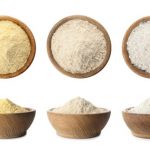
Culinary Quickies: Flours and Gluten
Reader Question:
Are all flours the same?
Answer:
 Simple answer, all flours are not the same and knowing the difference and how to use them is important and will impact your baking. It used to be that in most home kitchens there would be a container of flour and that would be used for baking, coating, thickening, and any other use flour was needed for. Today the grocery store shelves are stocked with a multitude of different flours, each with its own use. Flour is made from milled grains, nuts or seeds and each type has its own properties. Flours milled from wheat come in a wide range of varieties.
Simple answer, all flours are not the same and knowing the difference and how to use them is important and will impact your baking. It used to be that in most home kitchens there would be a container of flour and that would be used for baking, coating, thickening, and any other use flour was needed for. Today the grocery store shelves are stocked with a multitude of different flours, each with its own use. Flour is made from milled grains, nuts or seeds and each type has its own properties. Flours milled from wheat come in a wide range of varieties.
All Purpose Flour: This contains a mix of high gluten hard wheat and low gluten soft wheat. It is milled into a fine powder and can be used in most home recipes.
Whole Wheat Flour: Is made from milling the endosperm, germ, and fiber-rich bran of the wheat berry (seed). It is a heavier, denser flour and will have less of a rise. When using whole wheat flour one should allow ten to twenty minutes for the batter or dough to rest to give the bran and the germ time to absorb liquids. This will ensure a less dense finished product.
White Whole Wheat Flour: This flour is milled from the whole wheat seed head and should not be confused with bleached flours. White whole wheat flour is best for baking with a lighter texture than regular whole wheat.
Pastry Flour: This is a lighter flour that is often bleached and has a very low protein and gluten content. It is ideal for making pastry doughs, cakes, cookies, muffins, pie crusts and other fine baked goods. It isn’t recommended for breads as it is so low in gluten.
Cake Flour: Milled to a very fine consistency and most often bleached, creating a very light, whiter flour that is best suited for baking cakes. It has a very low gluten and protein content.
Bread Flour: This flour has a higher protein and gluten profile and is ideal for bread baking as it will develop glutenous fibers needed to make light fluffy breads.
Self Rising Flour: Made up of all purpose flour with baking powder and salt already mixed in, it is used in recipes that need a quick rise and shouldn’t be used interchangeably with other flours.
Vital Wheat Gluten Flour: Perhaps one of the most processed and engineered of the flours. It is made from wheat flour that has been hydrated and then reprocessed to remove everything but the gluten. Then it is dried and remilled to create flour. This flour is used in bread baking and to make seitan.
Sprouted Flour: This type of flour is made from grains that have already started to sprout. It is much more difficult to get used to baking with. It does however have a higher protein content and a deeper flavor.
Spelt Flour: Although lower in gluten than regular wheat flour, spelt is actually a more ancient form of wheat, and therefore does contain gluten and is not suitable for those with Celiac disease or gluten sensitivities. It comes in whole and white varieties and can often be used in place of regular wheat flours, but absorbs water differently, so adjustments will need to be made to recipes where spelt is substituted for wheat flour.
Gluten Free Flours: Gluten free flours come in many varieties and can be milled from nuts, seeds or grains which do not contain gluten. The use of these flours has become much more popular as more people are aware of their bodies’ intolerance to wheat either because of an illness like celiac disease or other digestive issues. Some of the varieties of G.F. flour are rice, oat, corn, potato, arrowroot, tapioca, sorghum, flaxseed, amaranth, tef, buckwheat, bean, and a wide variety of nut flours. In some markets wheat flour which has had all the gluten removed is also available, but may not be suitable for those with actual wheat (not only gluten) allergies. Using gluten free flour takes some getting used to and as the use of such flours has become more popular there are commercially made blends that make its use less challenging.
Reader Question:
In what products might I find hidden gluten?
Answer:
This is a doozy of a question. Someone that is allergic to gluten will need to be diligent when purchasing processed grocery products. Some common culprits that contain gluten are soy sauce, teriyaki sauce, marinades, salad dressings, gravies, BBQ sauces, vinegar, some ketchups and mustards, corn and rice cereals (if truly GF they will be labeled), soups and broths, cocktail mixes, french fries, imitation proteins, energy bars, flavored chips and other snack items. There are also some ingredients listed on processed foods that indicate gluten but under another name. Often the Latin name of an ingredient is used such as Triticum vulgare (wheat), Triticale (a cross between wheat and rye), Hordeum vulgare (barley), Secale cereale (rye), and Triticum spelta (spelt, a form of wheat). These of course all contain gluten. Malted products are glutenous as well.
To submit a question please email Shoshana at: foodeditor@unorthoboxed.com

Related Articles
Related
From Silence to Success – An interview with Marni Woolf
From Silence to Success An interview with Marni Woolf By Penina Taylor A rising star on the Israeli acting scene, no one would guess that Marni Woolf (nee Schamroth) didn’t speak until she was five years old. Labeled as autistic and doomed to never be a fully...
Culinary Quickies March 2023
Reader Question: How do I make clear chicken broth/stock? Answer: Let’s start by defining both stock and broth. According to classically trained chefs, stock is made from the bones with a few vegetables to season the liquid which when cooled will take on a gelatinous...
What’s Hot in Food & Cooking March 2023
In today's world of daily increasing food prices it is important to learn how to adapt our favorite recipes and to create weekly meal plans to keep the cost of food within our budgets. The best way to figure out your weekly food budget is to assess your current...
